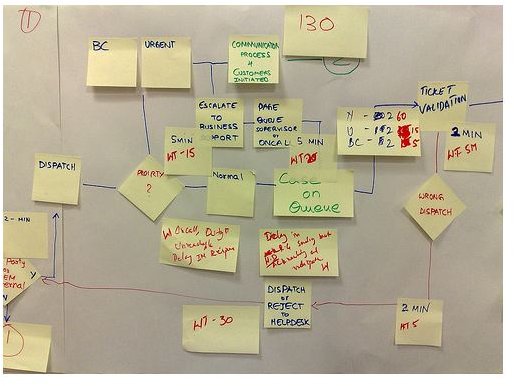A Look at Some Value Stream Map Examples and Tips on How to Use
What Are These Maps?
If we examine some value stream map examples, they are an illustration or flowchart of the sequence of activities involved in designing and producing a product, or offering a service; starting from the first steps in the making of a product to the point of sales to the end customer. These maps are based on the premise that any activity consists of a sequence of events and shows the various steps, delays, and information flows required to deliver the product in a “single page” or at a glance.
Value stream maps find major use in Lean processes to pin point the specific areas where waste occurs. Lean requires each event to add value to the product or the service. Mapping the flow of the product or service as it moves from one point to another allows identification of the value added in that specific activity and the stages between two activities, or whether the activity does not add any value, and is hence a waste.
A value stream map considers the entire supply chain and does not limit the analysis to the company or organization. This allows identifying the real problems to take effective countermeasures. For instance, the company may adopt a perfect Lean operation, but the benefits may be lost if the distributor of the product who takes the product from the manufacturer and provides it to the retail outlet is a basket case of inefficiency. Erratic distribution may result in reduced sales, frittering away the advantages of low-cost and high quality products brought about by Lean.
Application

One example of the application of value stream maps are in manufacturing processes, especially in Lean processes. Consider a manufacturing unit where partially processed units wait in queue for further processing. This exemplifies an inefficient process, as it wastes time. The value stream map may identify a possible bottleneck where one particular machine cannot match the pace of the previous activities in the value chain. The process owners can then work to resolve the bottleneck by redesigning the work flow, adding new machinery, or through some other way. In a similar way, a value analysis map may highlight unnecessary space, distance, processing inefficiency, and other ills of the manufacturing process.
Value stream maps also find use in services. Application of the value stream map for insurance claims processing, for instance traces the process and time from the point when a customer makes a claim to the time the claim is paid or rejected. The various process may include the customer making an application for the claim, the claims processing agency reviewing the customer’s account for eligibility, forwarding the claim for verification, the verification agency submitting the report, the accounts department releasing payment, and the customer being informed. Looking at a value stream flow chart, the project manager may make alterations to the work flow, change the customer’s claim format, or make other improvements to ensure speedy disposal of claims.
Very often, the project manager entrusted with cutting waste or improving process efficiency makes alterations in the “Current State Value Stream Map” based on what is possible, to derive a “Future Stream Value Stream Map” and then strives to convert this future state map to the current state map.
Example
First, download a free sample value stream map example from the Bright Hub Media Gallery. This map illustrates the value stream of a furniture manufacturing company. This is a simple map that illustrates the process. This is the most basic of value stream flowchart, to illustrate the concept.
The sample flow chart involves the following steps: Customer places order for custom furniture, storekeeper creates a work order; manufacturing plant accepts the work order; manufacturing plant creates work schedule, plant ordering raw materials; supplier shipping materials, the actual production process involving sorting of raw materials, cutting, smoothing, joining parts, polishing and drying; inspection, packing; billing; storage for transport; the actual transportation; the store receiving the product and informing the customer; and the customer taking delivery.
A more detailed value stream flow chart may illustrate the manufacturing process in detail, including movement of raw materials from stores to the plant, work schedules of different work teams, and more.
Looking at the flowchart, the project manager may try to reduce the time taken for various activities such as sourcing raw materials, conduct some activities such as billing simultaneously with other activities such as packaging to save time, eliminate non-value addition activity such as storage by advancing transportation arrangements, and so on.
A value stream map ranks as the most simple tool to obtain a bird’s-eye view of the process and make any necessary changes.
References
-
The Lean Enterprise. “Value Stream Mapping.: http://www.nwlean.net/toolsCD/VSM/4%20steps%20to%20VSM.pdf. Retrieved August 14, 2011.
-
Image Credits:
-
Joe Tidd, John Bessant, & Keith Pavitt. “Value Stream Analysis.” www.wileyeurope.com/college/tidd. Retrieved August 14, 2011.
